A guide to garden-tool shopping
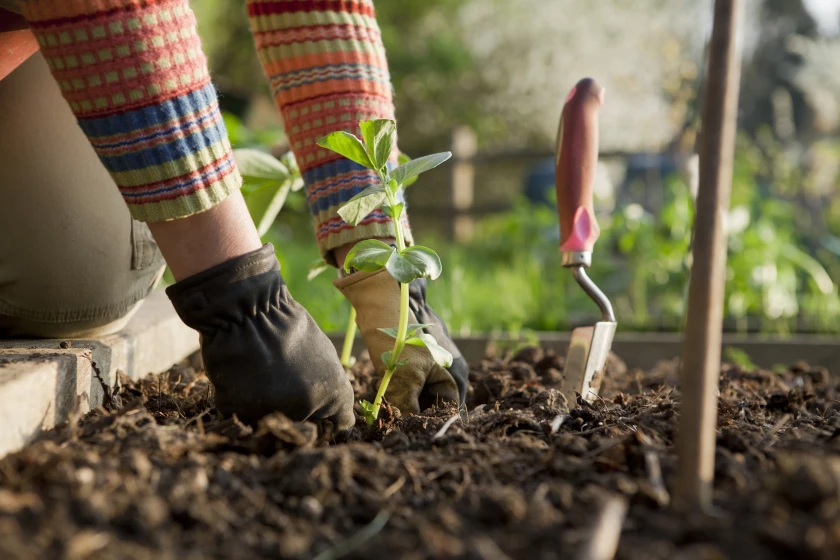
The proper tool, if well made and well cared for, can help the gardener on your gift list be more efficient and more comfortable during their next project.(Getty Images)
By Jodi Bay
(This article first appeared in the San Diego Union-Tribune on Dec 11, 2021)
It’s the holiday season, and you might be considering giving garden tools to the gardeners in your life or adding a few onto your list for Santa. Selecting the right tool makes gardening easier, safer and gives better results. When buying gardening tools, there are some factors to consider, such as fit, materials, features and uses.
For all tools, how it feels is important to ensure comfort and reduce the risk of injury. As it says in the fairy tale “Goldilocks and the Three Bears,” it has to be “just right.” Weight, handle lengths and widths vary. Tools that are too big or too small may result in hand or back fatigue. Long-handled tools — such as shovels and rakes — that are too short cause the user to bend. A greater than 30 percent bend from vertical may contribute to back fatigue and muscle spasms.
Materials for garden tools differ and are a determinant of price and quality. The metal in garden tools is either forged or stamped steel. Forged steel is heated and shaped for strength. These tools are the most durable and are more expensive. Tools made of forged steel will be labeled “tempered,” “heat-treated” or “forged.” Stamped steel is cut by a high-impact pressing and is weaker than forged.
Handles are either wood or fiberglass. Both are strong and, if well tended, can last a lifetime. Fiberglass handles are lighter, do not rot but are harder to replace if broken. Wood handles should have grain in the direction of the length of the handle but may crack or break if not maintained. Pruner handles are generally metal, but plastic is used for less expensive models. Adequate padding on the pruner grips increases comfort, and some of the ergonomic models have rotating handles or D-grips, which reduces hand fatigue.
Tools are designed for specific gardening tasks. Select tools that help the gardener with the tasks they do most often. A few to consider are:
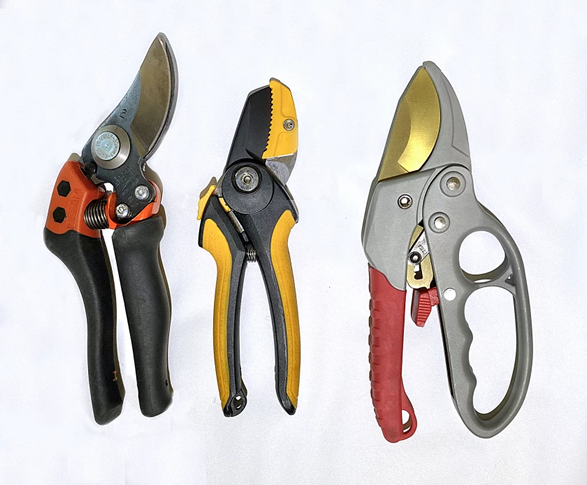
Pruners are used to cut plant material. Shown are (from left) bipass, anvil and ratcheted pruners. This bipass, for cutting live plant material, has an ergonomic design with angled head and rotating handles. Anvil pruners cut dry material, and the ratcheted pruner, with the D-grip handle, is a good choice for sore or weak hands.(Jodi Bay)
Cutting tools
These tools are used to remove plant material.
- Pruners are handheld cutting tools and come in three versions. Bypass pruners are for pruning live plants while anvil pruners are designed for cutting dried material. Ratcheted pruners cut in small bites and are helpful for those with sore or weak hands. Pruners will cut material up to ¾ inch thick.
- Loppers are the long-handled version of pruners and can cut branches up to 1½ inches thick.
- Pruning saws cut branches larger than 1½ inches. Consider a pole pruner or saw when cutting branches above shoulder height.
Digging tools
These tools move soil or other material.
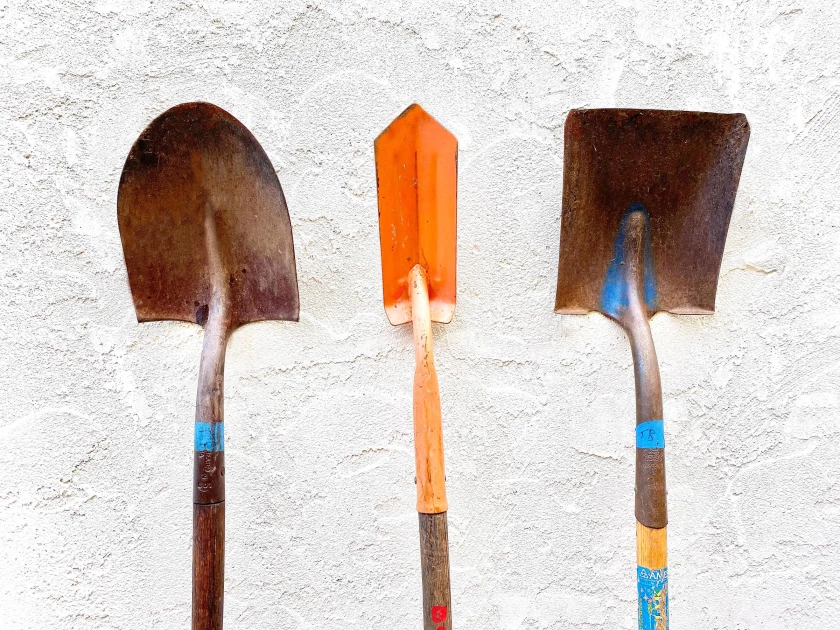
The three shovel types are (from left) rounded (spade), trenching and square point. Rounded is best for digging holes, and the trenching shovel is useful for digging in narrow spaces. The square point helps in moving material such as gravel or sand.(Jodi Bay)
- Shovels come in three types: spade (rounded), square-point and trenching. Spades are best for digging holes. Square-point aid in moving sand, gravel or mulch. They can also be used for cutting sod. Trenching shovels, with their narrow blade, are used for digging irrigation or other narrow trenches.
- Use a spading fork to loosen soil and to add compost.
- A pitchfork is useful for moving mulch, straw or other loose material.
- Trowels are the hand-sized version of a shovel and are used for digging small holes.
- Dibblers make planting seeds and bulbs easier. The best ones have a ruler etched onto them to aid in correct planting depth.
Weeding tools
- Scythes come in a variety of sizes and are used to remove weeds, cut grasses and reap grain crops.
- Stand-up weeders help the gardener remove weeds while standing, thus avoiding bending the knees or back. The claw stabilizes the weed and arm grabs it for removal.
- Hand weeders are simple, forked tools where the fork is inserted below the weed and lifts it out.
- Cultivators are three-pronged tools for breaking up and leveling soil, plus weeding.
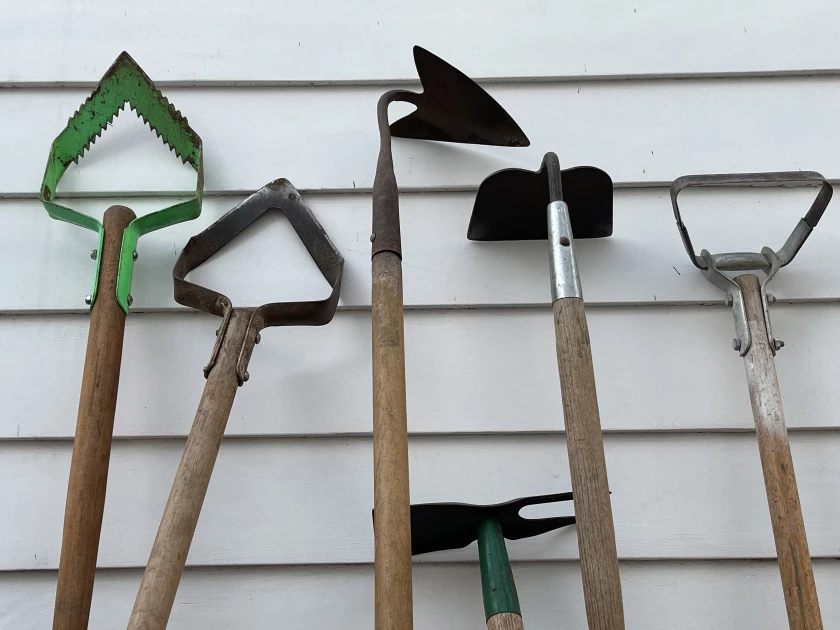
Hoes are used for weeding and digging. Hoes with an opening are categorized as scuffle hoes; ones that are solid are draw hoes. The first two on the left are push-pull hoes (scuffle hoes), next is an warren or anvil hoe, a paddle hoe (draw hoes), and an oscillating hoe (scuffle hoe). The one at the bottom is a combination field hoe and fork hoe.(DeLayne Harmon)
Hoes
Hoes are a versatile and broad category of garden tools that are primarily used for weeding and digging.
- Scuffle hoes remove weeds and are open in the center. They disrupt soil up to one inch deep, removing the weed and root.
- Draw hoes are used for digging and have a solid blade.
Multitaskers
These tools assist in more than one task. Some examples are hoe/cultivator, Hori Hori knife and weeder/trowel. They are a good solution for simplification and value.
Adaptive tools
These tools are designed to enable a gardener with pain or mobility challenges to continue gardening.
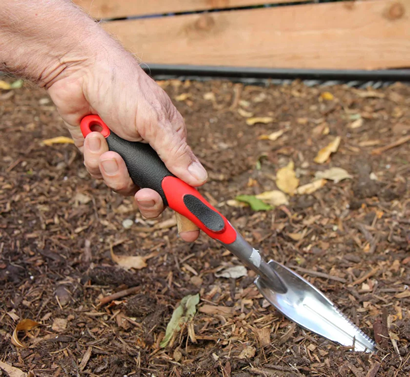
A trowel/weeder multitasker in action.(Jodi Bay)
- Ratcheted pruners cut with each closure of the grip.
- Swivel and D-loop handles ease pressure on hands.
- Ergonomic hand tools have a curved handle or an angled blade that engages the large arm muscles to do the work.
- Tools with telescoping handles help to extend reach.
- A portable stool enables gardening without bending.
If still unsure, gift items that make gardening more comfortable and safer. Hat, gloves, sunscreen, close-toed shoes are all necessary items. If working with chemicals, eye protection is a must and, for those hot days, a refillable water bottle.
In most cases, the better-quality tools are more expensive. Choose one that is within budget, fits the individual and does the job. Frequency of use is also an important decision factor. It is worth investing in a tool that will be used often. A good tool will be a good friend for many years.
For more information on gardening tools, go to the UC Master Gardener of San Diego County Web site, with a page on tool care: mastergardenersd.org/garden-tool-care
Bay has been a Master Gardener since 2012. She is the chair of the Tool Care committee, whose mission is to educate the gardening public on garden tool types, uses and maintenance. In addition, she is an instructor in the Beginning Vegetable Gardening workshops, which teach new gardeners how to grow healthy and bountiful vegetables.

